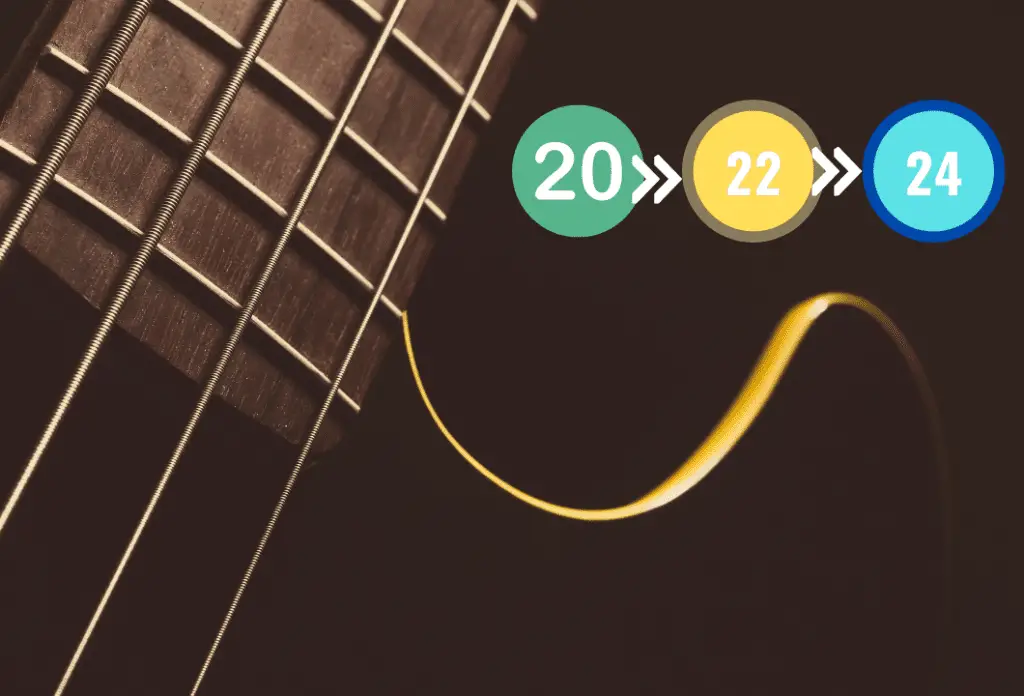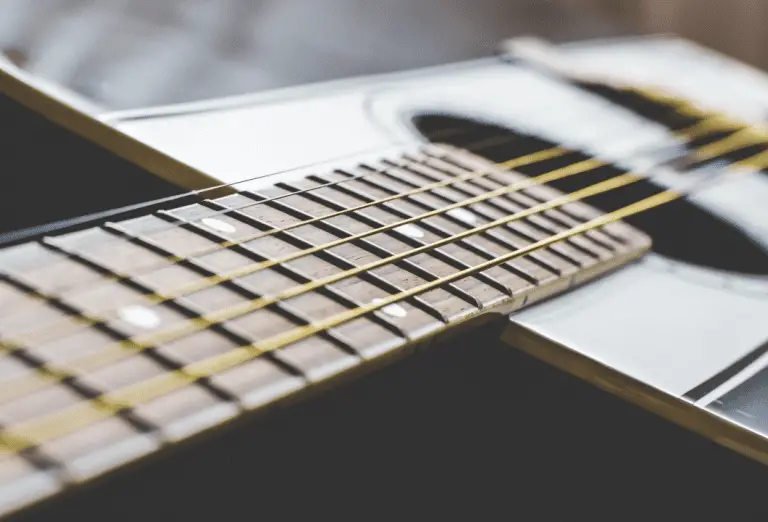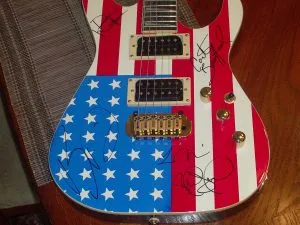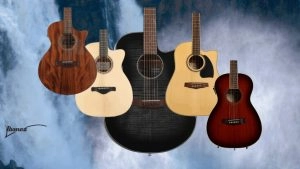Ever wonder how many frets there are on a guitar? You’re not the only one.
When beginner players shop for their first guitar, they will see a line in the technical specifications around the number of frets.
So, how many frets on a guitar — and what does it really mean?
There are typically 24 frets on a guitar, although some guitars have more or fewer.
The number of frets determines how high the notes can be played on the guitar.
For example, if a guitar has 24 frets, the highest note that can be played is two octaves above the open string, which is excellent for rock music. That’s because there are 12 notes in a single octave.
If a guitar has fewer than 24 frets, the highest note that can be played will be lower. For example, a 22-fret six-string guitar can play a high D. That’s two half steps lower than the high E a 24-fret guitar can play.
As a longtime player, though, I know that’s not the end of the great fret inquiry. All players, from beginners to advanced, often wonder if a guitar with more frets is technically better. Or are there advantages to guitars with more or fewer frets?
And that’s precisely what I’m going to explain.
• • •
What Are Guitar Frets?
Guitar frets are the raised ridges along the neck of a guitar that divide the strings into separate sections.

They are typically made of metal and are spaced evenly apart. When a guitar player presses down on a string, the string will make contact with the fret and produce a note.
The placement of the fret determines the pitch of the note.
Now that we have that out of the way, let’s dig into how many frets are on different guitars.
• • •
How Many Frets Are on Acoustic Guitars?
There are typically 20 frets on steel-stringed acoustic guitars, though some may have more or fewer depending on the specific model. In general, acoustics typically have fewer frets than electric guitars.
The most significant difference you’ll see amongst acoustic guitars is the number of frets above the body. They’re commonly referred to as 12-fret or 14-fret models, which signifies the number of frets above the body.
Let’s further explore the different types of acoustics and how they relate to the number of frets:
Number of Frets on a Standard Size Acoustic Guitar

On standard-sized, steel-stringed acoustic guitars, expect to have a total of 20 frets and typically 14 frets above the body. You’ll then find six frets between the sound hole and where the neck meets the body.
This fret setup accommodates all sorts of music genres since the strings can bend nicely, and you can easily access the upper frets.
When you play acoustic guitars, you have a few different body styles to choose from – and each one can impact the number of frets.
Number of Frets on a Parlor Size Acoustic Guitar

I love talking about parlor-size acoustic guitars because I own one — a Martin 00-17s. Parlor-sized acoustic guitars are 12-fret models — meaning 12 frets above the body — but still typically have 20 frets in total. Some models only go up to 18.
They are called parlor-sized because they were designed for small parties where a handful of folks would gather in — you guessed it — a parlor! They’re great for road tripping because of their size, but they still allow you to get the full acoustic experience.
Personally, I like how my arms can easily wrap around the instrument and the overall folksy tone of the guitar.
Number of Guitar Frets on a Jumbo Acoustic

Jumbo acoustics commonly only have 20 frets.
You’ll often see the word “jumbo” associated with acoustic guitars — like a Gibson Super Jumbo (SJ) 200, which just happens to be my bucket list guitar.
While jumbo means big, it only refers to the guitar’s body and overall feel.
How Many Frets on a Classical Guitar?
Classical guitars either have 18, 19, or 20 frets.

A ¾ scale classical acoustic guitar typically has 19 frets, with 12 frets above the body. On some models, like this Yamaha CGS103, the fretboard past the 19th fret is actually cut out to accommodate the soundhole. Upper fret access is typically an issue with classical guitars.
You can also find ¾ scale classical guitars with 18 frets.
A full-scale standard classical guitar also typically has 19 frets, but you can find some models with 20, which is closer to a more traditional acoustic.
• • •
How Many Frets Are on Electric Guitars?
Typically, an electric guitar has 22 or 24 frets, but there are instances of models having more or less.

A Squier Bullet Stratocaster, for example, is a beginner electric guitar with 21 frets. A Fender Stratocaster American Professional has 22 frets.
And a PRS SE Custom 24 has 24 frets (as its model name implies).
So, what are the main differences between all of these models?
Unlike acoustic guitars, where scale length can have a more drastic impact on playability and tone, the number of frets on electric guitars is more about overall tonal range.
In other words, you want a 24-fret guitar if you want access to those screaming high notes at the top that the two octaves provide.
Which is better: 22 Frets or 24 Frets?
More frets don’t necessarily mean a better guitar.

On 22-fret electric guitars, the neck pickup is typically further away from the bridge, which produces a warmer tone than a 24-fret guitar, where that pickup is much closer to the bridge.
If you’re a metal or heavy rock player, you may not necessarily desire that warmer tone, which is why you’ll see a lot of guitars by Schecter and Jackson — two brands known for making guitars for metalheads — with 24 frets. Those higher frets can produce really screaming-high notes.
But if you like the bluesy tones that Fender Strats and Telecasters typically produce, a 22-fret model might be better for you.
For the same reasons, if you are looking for a guitar that can deliver a nice jazz tone, a 22-fret will be superior to a 24-fret guitar.
27-Fret Electric Guitars
Twenty-seven fret electrics are rare, but they do exist.
As you may have expected, the higher range — your high E note can scream all the way up to a double-high G — is designed for metal and rock players. ESP, Ibanez, and Jackson are a few of the most notable guitar brands that sell 27-fret electrics.
Remember, a 27-fret guitar is going to be really close to the neck pickup, so don’t expect a buttery warm tone from those higher frets.
These more modern guitars will cost you more money.
Number of Frets by Popular Electric Guitar Model
Major guitar brands produce their stringed instruments with a varying number of frets — even when there’s a similar guitar neck size involved.
- Fender Stratocaster: 22 frets
- Fender Telecaster: 22 frets, but handy guitarists have modded necks to create a 24-fret Telecaster.
- Fender Jazzmaster: 22 frets
- Fender Jaguar: 22 frets
- Gibson Les Paul: A Gibson Les Paul typically has 22 frets, but custom models may have more.
- Gibson SG: 24 frets
- PRS Custom 24: 24 frets
• • •
How Many Frets Are on a Bass?

Like electric guitars, there are either 20, 22, or 24 frets on a bass.
Most bass players only need 20 or 21 frets. After all, accessing the upper range is typically not that important if you’re a bass player.
More advanced bass players, however, may want the extra frets, especially if they do more intricate bass solos.
• • •
Is the Number of Frets on a Guitar Important?
The number of frets on a guitar is an important factor to consider when choosing the right guitar for you. That’s because the number of frets dictates the size of the guitar neck, which in turn affects the playability and comfort of the instrument.

Most guitars with fewer frets will have a shorter neck, making it easier to play, while a guitar with more frets will have a longer neck, providing more range.
That said, some manufacturers keep the same scale length and jam in the extra frets. That can complicate accessing the higher notes and impact how pickups mic your guitar’s tone.
Ultimately, the decision of how many frets to have on your guitar comes down to personal preference and what style of music you plan on playing. That’s because the number of frets impacts the overall playability and even sound of your instrument.
• • •
Guitar Frets Are Your Roadmap to Great Playing
If you’re a beginner guitar player, you shouldn’t fret over the number of frets on a guitar.

Puns aside, most beginner guitars will have 20, 21, or 22 frets. All of them are still very capable instruments that allow you to learn how to play and improve.
You might start considering a guitar with more frets as you become more comfortable as a guitar player and want an instrument that allows you to reach higher notes.
Again, though, two extra frets only allow you to reach one whole note higher. Unless you’re constantly ripping solos in that range, it’s not desperately needed.
My best advice is to go to your local guitar shop and test out both acoustic guitar models and electrics to see which feels best in those upper fret ranges. Chances are, you won’t tell a huge difference between those with 20, 21, or 22 frets.









